Listen to the audio version of this article. Duration: 12 minutes.
Karim Rashid, one of the most prolific and influential designers of his generation, reveals his philosophy on how design shapes daily life and human behaviour. Known for making design a public discourse, the designer believes it goes beyond aesthetics, focusing on emotional connections with products that enhance everyday experiences.
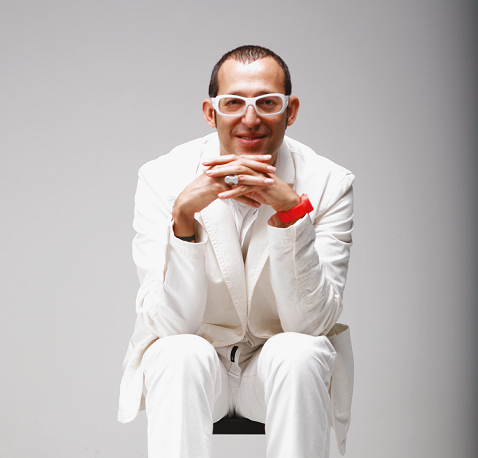
He emphasises the importance of sustainability and innovation, discussing how artificial intelligence is transforming the field. Karim also shares insights into his global, collaborative creative process, which has become more inclusive with remote teamwork and digital tools. His connection to outdoor spaces, especially during the pandemic, has further influenced his designs, inspiring functional, emotionally resonant environments that balance aesthetics with durability. Karim Rashid also offers visionary insights and practical advice for aspiring designers, and shares his perspective on the future of design in an ever-evolving, interconnected world.
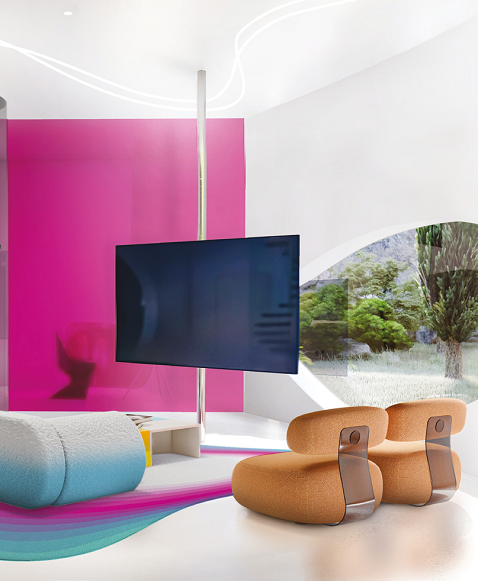
The Trip Concept House embraces a futuristic aesthetic, with fluid shapes and vibrant tones inspired by movement and energy. Its enveloping lines and bold color contrasts create a dynamic and immersive environment, challenging the traditional concept of living space.
How has your design philosophy evolved over time, and what principles have remained constant throughout your career?
My philosophy has not changed. It has been my mission to make design a public subject. I preach about how design shapes the future. I believe that design is extremely consequential to our daily lives and can positively change behaviours of humans. Products and furniture must deal with our emotional ground thereby increasing the popular imagination and experience. Good design can shift and change human behaviour and create new social conditions. Human beings touch an average of 600 objects a day, and the potential for those objects to benefit the everyday human experience is immense. I derive tremendous happiness from product design, because each object has the potential to connect with the consumer, and to bring them pleasure on an everyday basis. Beautifying the world, creating well designed, provocative, stimulating products and environments is the impetus for everything I embark on.
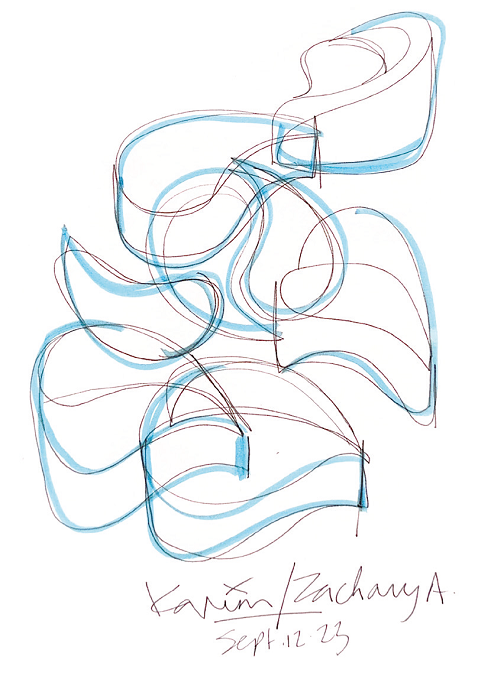
This sketch of Polli captures the fluidity and vibrancy of the final piece. With playful curves and bold geometry, Polli blends organic inspiration with a futuristic aesthetic, pushing design boundaries.
Can you describe your creative process from concept to final execution?
My favourite part is the initial spark of inspiration. One can think sculpturally and conceptually of the idea. My approach and process have not changed much over time. I’m no longer spending hours hand-drawing very technical drawings like I was early in my career, before I started my studio. Instead now I sketch, hand the sketches off to my team to be built and rendered in 3D. It is imperative to start with the concept then develop a form around it.
Since the pandemic my team works remotely all around the globe. It has always been my dream to overcome the distance and become a more collaborative and kinder society and industry. I meet with my team and clients on Zoom and Teams and Whatsapp from all over the globe. The communication allows for a more personal connection with my clients and staff that doesn’t exist when you’re communicating from behind the veil of an email. Collaboratively we must find new languages, new semantics, new aesthetics, new materials, and behavioural approaches. This is how we change the world!
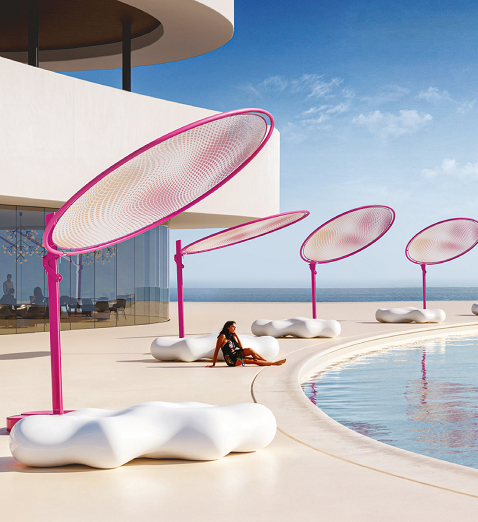
By the pool, the Lava Lounger for Vondom (2010) creates an elegant, futuristic outdoor haven. Karim’s hallmark of blending bold design with fluid functionality is perfectly expressed in these pieces.
What role does technology play in your design process?
I loved the idea of a mechanically driven aesthetic, of using technology as a basis of my work, of exploiting technology, be it software or hardware, of seeing how far a production machine can go. Sottsass said that the machine once controlled us, meaning that our forms, our physical results were only as good as our technology permitted, but today we control the machine, meaning anything we imagine can be built. Bauhaus saw industrial production and artistic creation as one seamless condition and even was instrumental of the beginning of the democratisation of design - To be is to Build.
How do you approach the challenge of designing outdoor spaces compared to indoor environments?
Outdoor furniture that embodies human qualities like emotions, usability, humor, positive energy, and proud spirit is so often what is missing in design. Breaking the conventional rigidity, bulkiness, and banality in outdoor furniture, my designs introduce softness, playfulness, and sensuality that creates a visual fluidity yet being functional and ergonomic.
How do environmental factors like weather and climate influence your outdoor designs?
Outdoor must address the needs of the contemporary environment, whether it be using perforated metal in a chair to conserve materials and allow water to drain through rather than pooling and saturating the seat, or building a lounger that is lightweight, affordable, durable, iconic, and recognisable in the NOW. Or using materials and manufacturing processes that hold up to sun, sand, rain, hail.
What’s your personal relationship with outdoor spaces?
Living through the pandemic made me realise how important it is to connect with the outdoors. I just built my dream house - a futuristic yet economical house in the country with panoramic views, decks and a pool. I want a home with no sharp corners and no obstructive columns. By using organic and sculptural forms and minimising the visual weight in my design I alleviate mental pressure, creating an inviting and friendly landscape for gathering and outdoor pleasure that matches the interior energy.

What’s your favourite way to spend time outdoors, and what’s your favourite outdoor food?
I love to exercise, cook and work on my mental and spiritual health by going to lots of museums and galleries and embracing creativity on every level. I love sketching, reading philosophy, listening to music, dancing, lying by a pool, sleeping and being in love. I love dreaming and thinking about the world, about love, about people, about peace, about beauty, and about one romantic, engaging, fulgent, energetic, seductive, inspiring place we call earth.
“Design shapes the future, connecting with people and transforming everyday experiences”
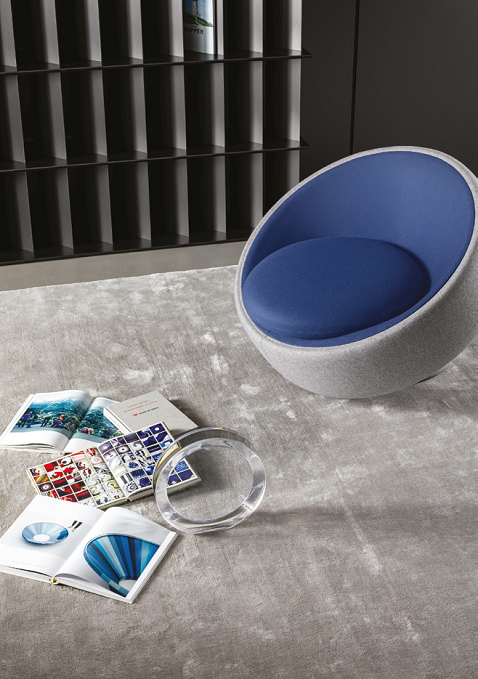
The Globalove armchair for Bonaldo, offers a sculptural form inspired by purity and natural orbits. Its enveloping comfort and bold, contrasting colours add a dynamic and modern touch to outdoor environments.
What advice would you give to aspiring designers looking to make a mark in the industry?
For young designers I always give the advice: Be smart, be patient, learn to learn, learn to be really practical but imbue poetics, aesthetics, and new paradigms of our changing product landscape. You must find new languages, new semantics, new aesthetics, experiment with new materials, and behavioural approaches. Also always remember obvious HUMAN issues in the product like Emotion, ease of use, technological advances, product methods, humor, and meaning, infusing a positive, energetic and proud spirit in the product.
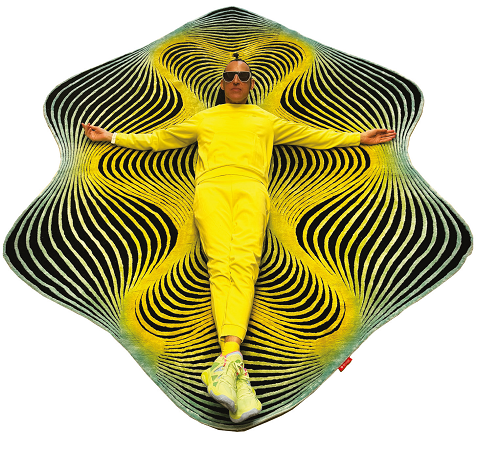
The Digipop Collection (2005) for W Studio features bold, vibrant designs with three-dimensional optical effects, crafted in high-definition on fine wool. These rugs double as both floor coverings and eye-catching wall art.
What’s your approach to AI and new technologies? Challenge or opportunity?
Regarding Artificial Intelligence, I believe that we can do better. I’ve always embraced change. Whether it was at university, outsourcing my models to professionals, or being the first designer to use 3D printing in my studio 20+ years ago. I have been experimenting with AI but I have my doubts about it. With thousands of images of my work in the virtual realm I notice many designers are sending me work and just with my name and a few words it generates very amazing imagery that looks like I designed it. So it becomes too easy especially for students. It is not from their soul or vision and they have not learned to conceive their ideas. Also a strong concept is critical for good design and AI at this point is only superficial style. This is very concerning.

Made from laser-cut, folded aluminum, the Kanvas Collection (2022) tables and chairs by Punto Design reflect a modern approach to outdoor furniture, with minimalist forms that merge functionality and comfort in versatile materials.
How do you stay inspired and where do you find your creative inspiration?
I read journals about technology and materials, visit my client’s factories, see new technologies at the trade fairs at which I lecture, and listen to the expertise of my clients. Industrial design and interior design are driven by designers embracing new technologies, whether it is material chemistry, production method, or mechanical invention.
I feel like inspiration and innovation come out of limitations. If we had many resources, there would be no experimentation. Sometimes my most creative work has come out of a small budget for interiors or limitations with tooling. I have also learned that many designers do a great deal of work, but we end up not seeing most of it and it remains in concept form only because the key to putting work on the market is to make sure it is a collaboration. If you work closely with a client and understand their needs, you can be much more productive. Design is collaboration and when I listen to my clients, their needs, then the outcome will likely be produced. And for me, I am not interested in just concepts. I need it to manifest my ideas. You know, the solutions to our problems are in front of our eyes, you just have to see them.
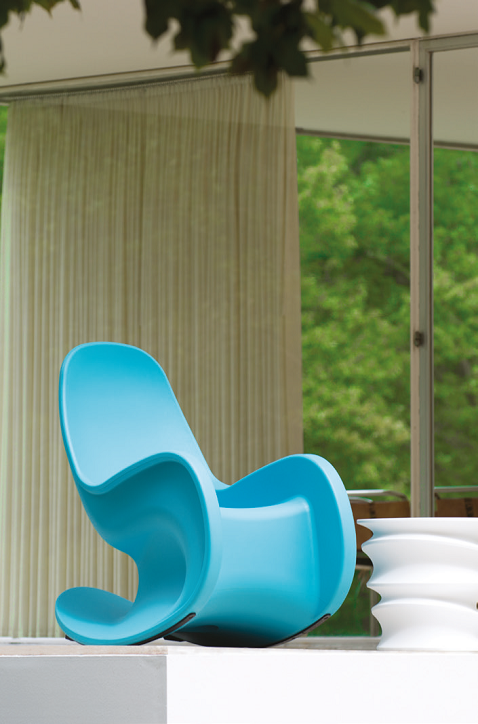
The Huey Chair by Tonik (2017) is a sleek, modern rocking chair crafted from high-impact polyethylene for both indoor and outdoor use, with UV-resistant durability and smooth rocking motion.
In what ways, if at all, has your cultural background influenced your work?
I am a global citizen. But looking at location, place, and culture always means looking back. I am interested in looking forward, looking outward and the world is becoming one. I love the shrinking unification of the world because it affords all of us to be inspired by every culture, every person, everywhere and anytime. But at the same time what is in your mind, blood, memory, experience will end up in your work regardless. This is the ultimate combination of interesting and beautiful work. I love all countries and inherently my work will reflect my background and the world in which it is placed.
Also, today if a product is an Italian brand and I am the Designer (half English half Egyptian Canadian American) and the engineer is Dutch and parts of the lamp are from Taiwan and other parts are Chinese and assembly is in Italy and marketing is Italian etc. then does that design have an origin? Is it Italian design? I believe it is not relevant anymore where things are produced or even one’s nationality.
“Human beings touch an average of 600 objects a day, and the potential for those objects to benefit the everyday human experience is immense”

The Sloo collection chair (2013) for Vondom made of durable polyethylene, blends fluid, organic lines with modern design, and has been recognised with a Red Dot Design Award for its innovative approach to indoor and outdoor seating.
“A strong concept is critical for good design, and the solutions to our problems are in front of our eyes; you just have to see them”

The Bound Collection (2022) for Nowy Styl features a series of soft seating options, including an armchair, sofa, and table, designed to foster human interaction through its comfortable, minimalistic aesthetic.
Bio
Karim Rashid, an Egyptian-born and Canadian-raised designer, is a leading figure in industrial design with over 4,000 designs in production across 40 countries. He holds a Bachelor of Industrial Design from Carleton University in Ottawa and pursued further design studies under Ettore Sottsass in Naples, Italy. His diverse portfolio spans luxury goods for Christofle and Veuve Clicquot, furniture for Bonaldo and Vondom, and high-tech products for Samsung and Asus. His interior designs include iconic spaces like the Semiramis Hotel in Athens and Universita Metro Station in Naples. Karim has received numerous prestigious awards, including the Red Dot Design Award, George Nelson Award, and Pentawards, and his work is featured in 20 permanent collections worldwide, including at MoMA and the Centre Pompidou. A frequent lecturer on the importance of design, he holds honorary doctorates from OCAD University, Pratt Institute, and Carleton University. Known for his philosophy of creating accessible, emotionally resonant products, Karim blends innovation with sensual minimalism to shape everyday life.
Copyright © Homa 2025
All rights reserved

.jpg?VGhlIFBlcmZlY3QgU2xvdC1pbijmraPnoa4pLmpwZw==)

































